We’re approaching halftime, folks—halftime in the year-long wait between season premieres of Game of Thrones, that is. If you’re among the show’s millions of fans, you probably start craving another fix as soon as the show goes off the air—so I figure it’s never too soon to interrupt the hiatus and jump back into Westeros.
But before we go there, let’s talk about California wine country. I was married there last year. My wife walked the aisle to Canon in D, a classic composition by Baroque composer Johann Pachelbel. For my own walk, I choose a modern tune by a composer named Ramin Djiwadi. Played on the violin, you might not recognize his sweet, powerful notes as the opening of Game of Thrones—but the guests who did loved it, and so it was that I was happily married in sight of the Old Gods and the New.
Naturally, I often hum the show’s theme song (with these lyrics of course)—and recently, it occurred to me: of every opening sequence in the history of television, there is none I love so much as the opening of Game of Thrones. Not just because the music is awesome. Or even because of the cool 3D map which does a great job of invoking the idea that the world is an intricate game. What I really love about the opening is that it’s a kind of table of contents for the upcoming episode; the opening sequence changes a little every week, reflecting the new developments in the sprawling narrative. That first minute with the world map is the one thing that links together all the pieces—joining together the show’s various story worlds.
Game of Thrones is really a collection of many story worlds, including the Seven Kingdoms of Westeros (the North, the Riverlands, the Westerlands, the Iron Islands, the Vale, the Stormlands, and the Reach), the Nine Free Cities (I’ll spare you the list), and the many lands across the sea. And each unique story world on George RR Martin’s fantastic planet is truly a standalone entity, capable of being the setting for its own rich and gripping story. Which, often, it is.
Martin is notable amongst fantasy authors for having been a short story writer for decades before hitting it big with A Song of Ice and Fire (the book series on which Game of Thrones is based). As a result, he knows how to set up worlds, characters, and plots in just a few pages. The books themselves often read as a collection of interlocking shorts, even though characters and storylines persists across the series. The TV show mirrors that style; in fact if there’s one criticism to be leveled at HBO’s show, it’s that it sometimes feels disjointed as a result of jumping between narratives. But then, that’s the nature of this beast.
Let’s look at a few of the story worlds within Game of Thrones.
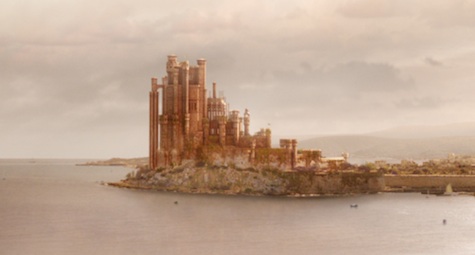
In King’s Landing, the capital of the Seven Kingdoms, stories revolve around political intrigue. This is a place of secret alliances and back room meetings, of manipulated marriages and staged assassinations. In the show, the city has a pale, golden color, dominated by towers and spires and all the trappings of a palace. Even though winter is coming, it feels very much like summer. King’s Landing is a unique, identifiable place that audiences immediately recognize, with or without an establishing shot.
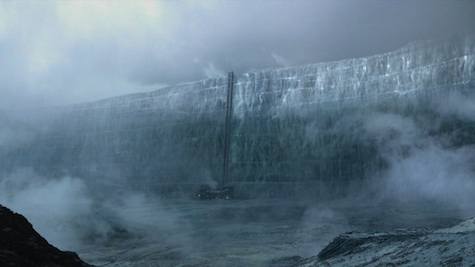
Now jump to The Wall, in the snowy north. This massive barrier of solid ice is a thousand feet high and thousands of miles across, built millennia ago by exiles and murderers in a brotherhood both sacred and deadly. Brothers of the Night’s Watch dress all in black, a stark contrast to the white world around them—mirroring the values of the Night’s Watch itself. The stories of Jon Snow and Samwell Tarly have little to do with politics—they’re closer to survival horror, focusing on the threat of the Wildlings and the White Walkers that threaten to invade from further north.
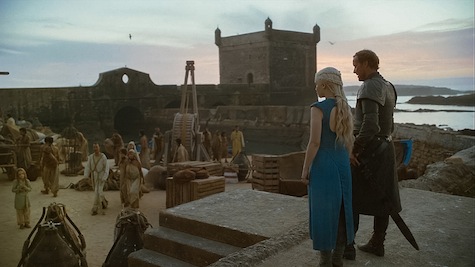
Across the Narrow Sea lies Slaver’s Bay, where Daenerys Targaryen leads an army of freed slaves to a desert city where opulence is matched only by cruelty. Even amongst the exotic locals, Daenerys stands out as a picture of eastern eclecticism: she wears silks, rides a white horse, is “mother” to three colorful dragons, and is followed by loyal barbarians and servants, few of whom speak her native Westerosi. Cultural values amongst these foreign lands are as bizarre as the foods they eat, and every new city she comes to seems to hold a new shock for the viewer. Stories in Khaleesi’s world are in the vein of epic drama, tracking the rise of a young girl into a mighty Queen.
What do these three story worlds have in common? Not much. With different settings, different characters, and different genres… they’re as unique from one another as three worlds can be. Yet they are all part of the same story. And that’s the genius of George RR Martin. You’d never confuse the barren lands of Winterfell with the towering peaks of the Vale. You’d never mix up the volcanic crag of Dragonstone with the dangerous shores of Great Wyk. Every story world in Westeros and Essos feels visually, culturally, and thematically distinct—and yet it all ultimately fits together.
He accomplishes this through close attention to detail. For instance, consider his depictions of the Great Houses. You may have read fantasy books where nations are defined as “the people who build ships,” or the “folks who smoke the good tobacco.” Not so in Game of Thrones. The world of the Starks is very different from the world of the Lannisters, which is very different again from the worlds of the Targaryens or the Greyjoys. Local attitudes, ways of speech, tools of war, sexual mores—they all change radically from country to country.
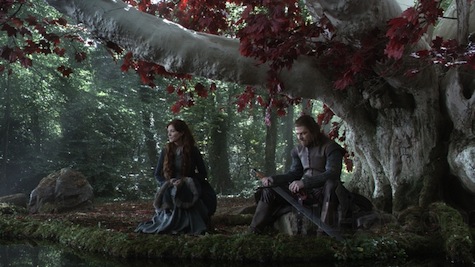
Or consider how Martin handles religion. In the south, men and women worship Seven Gods: the Father, the Mother, the Maiden, the Crone, the Warrior, the Smith, and the Stranger. In the north, people worship the Old Gods, as faces carved into Heart Trees. On the Iron Islands, the Ironborn worship a brutal Drowned God, who thrives on human sacrifice. And elsewhere, Red priests and priestesses pay homage to R’hllor, the Lord of Light, who grants dark miracles to his feverishly devoted. All that ties these religions together is the fact that they co-exist on the same planet, and that their followers intermix and often conflict.
This is all awesome world-building. And by no means is this an exhaustive list, just a very quick taste. George RR Martin is like a master swordsman, carving up the generic muck of fantasy clichés and building something entirely new from the pieces. His world is constantly fresh, inspired by real human history, turning all genre conventions on their head and walking the razor’s edge of storytelling. He knows what audiences expect, and swerves from those expectations before he ever gets there. In short, he’s a brilliant world-builder and storyteller (and D.B. Weiss and David Benioff have done a great job adapting it all for the screen.)
Game of Thrones is a great example of how world-building can make a story reach beyond a genre to appeal to wider audiences. Which is why there are some 14 million people out waiting patiently for the next season—record numbers for a show in the fantasy genre. Luckily, there’s still a lot of story left to tell, so we’ll all be hearing that epic theme song for at least another four seasons. In the meantime… watch old episodes, read the books, and appreciate what is probably be the most complex story world on television.
Brad Kane is a writer in the entertainment industry, focusing on storytelling in movies, TV, games, and more. If you enjoyed this article, take a second to like his page on Facebook and/or to check out his blog. He also has a new Twitter account that he is trying to remember to use.










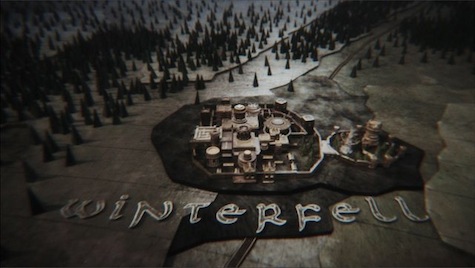
Game of Thrones has one of the greatest-ever theme song arrangements and main title sequence.
As for the worldbuilding, I absolutely love that GRRM has made it possible to tell his version of every epic fantasy tale within the same world–rise to power, survival horror, political intrigue, epic war.
Tiny quibble, but Dorne (rather than the Riverlands) is one of the seven kingdoms.
I do love you had the theme played at your wedding.
Apsalar @2: It’s funny, I’ve never actually thought about what regions specifically comprise the Seven Kingdoms before now :) It looks like you’re right, according to the Wiki of Ice and Fire:
The Seven Kingdoms are divided into nine administrative regions, seven of which, The North, Iron Islands, the Vale, The Westerlands, The Reach, the Stormlands and Dorne, were independent kingdoms at the time of conquest. The Riverlands had been independent before, but had fallen to the Storm Kings and more recently to the ironborn. They regained independence after the local lords rebelled against Harren the Black and swore fealty to Aegon during the conquest. The area around King’s Landing, which had also been a battleground between several kingdoms, constituted the royal demesne and became known as the Crownlands
@2 and 3. The Seven Kingdoms in the name are The North, Iron Islands, Vale, Westerlands, the Reach, Stormlands and Riverlands. These were the seven kingdoms ruled by Aegon the Conqueror. Dorne was not counted since it was not conquered until several decades later. At that point, the country could have changed its name to Eight Kingdoms, but they didn’t.
This is just one of the many complicated details included in the books which makes the worldbuilding in this series so great. Fantastic. Stupendous. Wonderful.
@2, 3 and 4…The Seven Kingdoms are The Kingdom of the North, the Kingdom of the Mountain and the Vale, the Kingdom of the Isles and Rivers, the Kingdom of the Rock, the Kingdom of the Reach, the Kingdom of the Stormlands and Dorne. Aegon himself did not conquer seven Kingdoms…he conquered six. Dorne came into the fold after his death.
Another small quibble. The Wall is only 700 feet tall at its highest point. And about 300 miles long, from the Frostfangs mountains in the west to the Bay of Seals in the east. It is made not only of ice, but of stone as well. But anyway, this article was a great tribute to Martin’s ability to create entire worlds, and his ability to inspire people like me to sweat over the story’s details — like the height and composition of The Wall :) Cheers
Nice article. However, the Seven are not seven gods, but one god with seven aspects/faces.